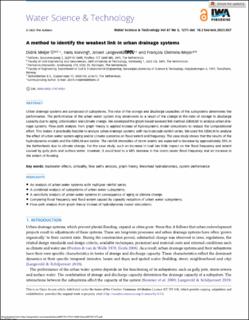| dc.contributor.author | Meijer, Didrik | |
| dc.contributor.author | Korving, Hans | |
| dc.contributor.author | Langeveld, Jeroen | |
| dc.contributor.author | Clemens-Meyer, François | |
| dc.date.accessioned | 2023-10-30T08:40:11Z | |
| dc.date.available | 2023-10-30T08:40:11Z | |
| dc.date.created | 2023-05-15T15:22:43Z | |
| dc.date.issued | 2023 | |
| dc.identifier.citation | Water Science and Technology. 2023, 87 (5), 1273-1293. | en_US |
| dc.identifier.issn | 0273-1223 | |
| dc.identifier.uri | https://hdl.handle.net/11250/3099302 | |
| dc.description.abstract | Urban drainage systems are composed of subsystems. The ratio of the storage and discharge capacities of the subsystems determines the performance. The performance of the urban water system may deteriorate as a result of the change in the ratio of storage to discharge capacity due to aging, urbanisation and climate change. We developed the graph-based weakest link method (GBWLM) to analyse urban drainage systems. Flow path analysis from graph theory is applied instead of hydrodynamic model simulations to reduce the computational effort. This makes it practically feasible to analyse urban drainage systems with multi-decade rainfall series. We used the GBWLM to analyse the effect of urban water system aging and/or climate scenarios on flood extent and frequency. The case study shows that the results of the hydrodynamic models and the GBWLM are similar. The rainfall intensities of storm events are expected to increase by approximately 20% in the Netherlands due to climate change. For the case study, such an increase in load has little impact on the flood frequency and extent caused by gully pots and surface water. However, it could lead to a 50% increase in the storm sewer flood frequency and an increase in the extent of flooding. | en_US |
| dc.language.iso | eng | en_US |
| dc.publisher | IWA Publishing | en_US |
| dc.rights | Navngivelse 4.0 Internasjonal | * |
| dc.rights.uri | http://creativecommons.org/licenses/by/4.0/deed.no | * |
| dc.title | A method to identify the weakest link in urban drainage systems | en_US |
| dc.title.alternative | A method to identify the weakest link in urban drainage systems | en_US |
| dc.type | Peer reviewed | en_US |
| dc.type | Journal article | en_US |
| dc.description.version | publishedVersion | en_US |
| dc.source.pagenumber | 1273-1293 | en_US |
| dc.source.volume | 87 | en_US |
| dc.source.journal | Water Science and Technology | en_US |
| dc.source.issue | 5 | en_US |
| dc.identifier.doi | 10.2166/wst.2023.057 | |
| dc.identifier.cristin | 2147650 | |
| cristin.ispublished | true | |
| cristin.fulltext | original | |
| cristin.qualitycode | 1 | |

